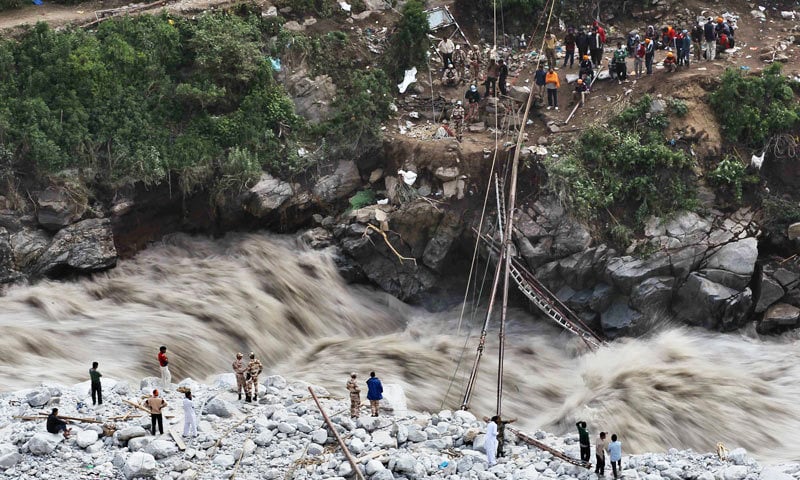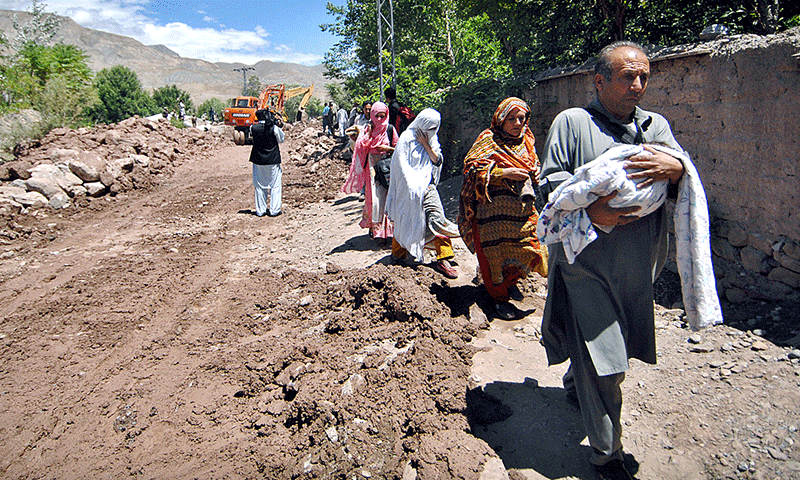As widespread flooding devastates large parts of the Chitral District, paralysing life in Mustuj, Lot Koh and the Kalash valleys, government experts are putting most of the blame on what, in climate change lingo, is described as “Glacial Lake Outburst Floods” or GLOFs.
GLOFs are floods caused by valley glaciers melting because of warmer temperatures in the summer months, and forming lakes – hidden or visible – which then break out of the moraine and ice that dams them. The water gushes below into the valleys at great speeds, destroying everything in its path.
A couple of years ago, I visited Sonughure village in north Chitral to witness the devastation caused by a GLOF earlier. Around half the village had been wiped out and the ground was covered with huge boulders and sand (brought down by the flood), which rendered it unusable for agriculture.
The local villagers were worried about the possibility of their valley glacier, perched high above on a mountain ridge, melting again because of high temperatures in the summers.
Last week, the National Disaster Management Authority issued a fresh GLOF warning. However, in the recent floods in Chitral, eyewitnesses have reported another phenomenon altogether.
Read on: Lost livestock: Bleak days ahead for flood-affected Chitralis
Glacial melt or monsoon rains?
Zainab Alam, a mother of three, told me that she had never seen it rain like this in Chitral before; nonstop rains every day for weeks. And she has spent every summer of her life in Chitral, where her family runs a hotel, the imposing Hindu Kush mountains located above Chitral town.
Zainab's father, Siraj-ul-Mulk, who has been a pilot for most of his life and can recognise monsoon clouds, suggested that the monsoon has shifted to higher altitudes from upper Punjab all the way to Chitral, Skardu and Gilgit; it is now penetrating the north of Pakistan.
The Hindu Kush range which passes through Chitral, is made up of towering mountains with little greenery; when it rains, the water rushes off the steep slopes and below into the nullahs, streams and rivers cutting through the mountains.
Siraj doesn't believe that the floods were caused due to melting glaciers. He claims that Pakistan International Airlines (PIA) pilots who fly to Chitral told him that the clouds spread from Skardu to Chitral, and that they had never seen this cloud formation at this time of the year before.
The floods have caused immense damage to large parts of the district, destroying homes, bridges, roads, orchards, standing crops and water channels and killing hundreds of livestock. The newer concrete bridges could not withstand the floods like the earlier suspension bridges.
See: Flash floods again inundate several villages in Chitral
 |
| Men crossing a destroyed bridge during flooding in Chitral, June 2015. —AFP |
With the bridges gone, entire valleys are cut off. Around 40 people have lost their lives so far and around 600 houses have been swept away. It starts getting cold in October, so people who have lost their homes need winterised tents. For now, most of them are staying with relatives. The Khyber Pakhtunkhwa government has handed over relief efforts to the Pakistan Army, who are now trying to restore the road links and bring in steel bridges.
Where did all these glacier lake flood explanations come from?
Ghulam Rasul, the Director General of the Pakistan Meteorological Department (PMD), says that the rainfall has only been around 20-25 mm per day, according to the few weather observatories present in Chitral District. He says that the department doesn’t have a dense network of observatories in Chitral; only in Chitral town, Bindu Gol valley and Golan valley. He believes the rainfall caused the glaciers to melt.
I ask him, which glaciers, exactly?
Ghulam Rasul says there are glaciers all over Chitral’s valleys, and they are melting due to global warming and becoming destabilised. The persistent rainfall triggered the glacial melt – the warmer rainwater in comparison to the ice caused the ice to melt faster.
The heavier water then sat at the base of the glacier, creating ponds underneath. When the capacity was filled, Glacier Lake Outburst Floods took place. Sometimes, the lakes (caused by glacial melt) are visible and can be monitored, but sometimes they are hidden under the surface of the ice and can’t be monitored.
PMD is part of a multi-million dollar project called “Reducing Risks and Vulnerabilities from Glacial Lake Outburst Floods in Northern Areas”, that is currently being implemented in Bindu Gol Valley in Chitral and Bagrote Valley in Gilgit by the government, with help from the United Nations Development Programme.
I visited both locations back in 2011 when the project was starting, and to be honest, I was not impressed. So much money being invested in research, surveys and “awareness raising” in areas that have already been well-researched by other NGOs in the past.
The local people have high literacy rates in this region and they are well aware of the problems they are facing; after all they have lived in these valleys for centuries and have indigenous knowledge and their own early warning systems (local mosques, warning fires on mountainsides, etc.).
The local people were not consulted when the project was being designed. Besides, in these tough mountain valleys, it is the communities who help each other when a disaster strikes, so why not train the villagers themselves and give them the right equipment instead of the line departments?
It appears to me that the government has a vested interest in ensuring this project gets an extension – hence all this talk of Glacier Lake Outburst Floods and the need to monitor the lakes.
I turned next to a Disaster Risk Reduction (DRR) specialist who happens to be from Chitral. Syed Harir Shah has worked in this field for the past 20 years and his more recent jobs were with the German NGO called GIZ and with the German Red Cross.
“I would say that in 90 per cent of the flood-affected areas in Chitral, there are no glaciers. I have also never heard of a glacier bursting because of rainfall; they melt because of heat. I was in Chitral when these rains started during the Eid holidays, and it was actually quite cool in my village – around 23 degrees Celsius. I have witnessed myself that the recent flooding was 100 per cent caused by torrential rainfall.”
 |
| Locals stand against the wall of their flooded houses located near a stream overflowing due to heavy rains in a suburb of Peshawar, on July 26, 2015. —AP |
Harir left his village, Mardan, for Chitral Town when the rain kept falling, worried that there would be a major flood. He says he had anticipated it and warned his fellow villagers to move to safe areas as well, away from nullahs. The next day, there was a massive flood in his village and the valley was cut off. According to him, there were no glaciers there; these are dry mountains and the rainfall came down from cloud bursts.
“I don’t know how people can make these statements about GLOFs sitting in positions of such responsibility. Yes, there have been GLOFs in the past in Chitral in several valleys, but not this time.”
Also see: After Chitral, flash floods and rain devastate vast areas across KP
For Syed Harir Shah, the biggest worry is the unusual shift in the monsoon. This needs to be studied and researched more. How did it shift? How come no one knew about it?
Climate change scientists have long been pointing out that there's a connection between the strength of the greenhouse effect and the Asian monsoon system, and that the monsoons may be more sensitive to global climate change than we thought earlier.
The latest UN Intergovernmental Panel on Climate Change projections suggests an increase in both average and extreme rainfall in South Asia in all scenarios of future emissions. With intensified monsoonal precipitation in Asia predicted, what our scientists need to be doing is to responsibly and definitively figure out just how Pakistan will be affected, so that appropriate DRR measures can be put in place.
















































